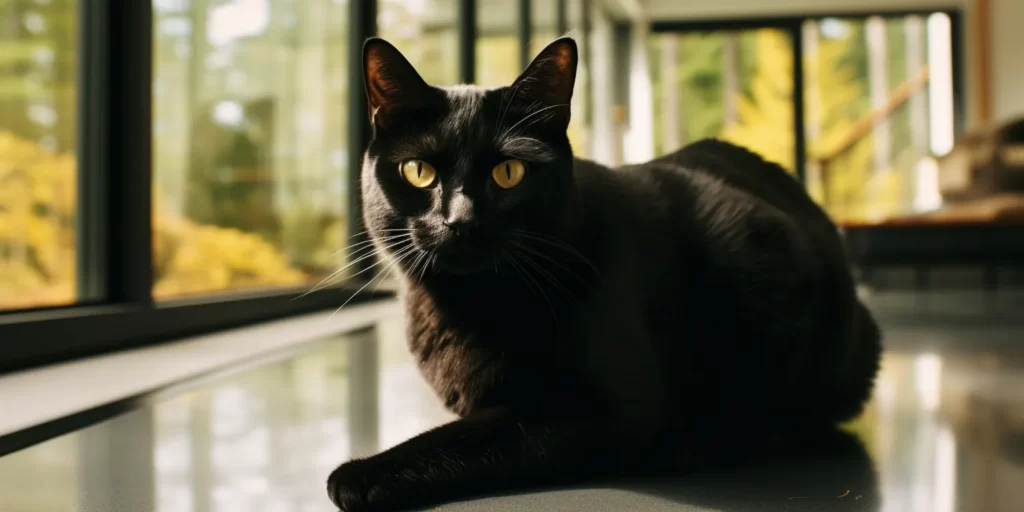When you are considering adding a Bombay cat to your family, you may find yourself pondering over the differences between males and females of this sleek and captivating breed. It’s an age-old question for potential cat owners: what are the pros and cons between a male and female Bombay cat?
The Bombay breed, known for its panther-like appearance and affectionate temperament, does exhibit some distinctive traits and behaviors that vary depending on whether the cat is male or female. In this comprehensive guide, we will explore the various aspects that set them apart, helping you make an informed decision for your home and lifestyle needs.
Choosing between a male vs female Bombay cat involves considering temperament, size, health, and household dynamics. Whether you’re a seasoned cat owner or venturing into the world of pet ownership for the first time, understanding these differences is crucial.
Join us as we delve into the world of these beautiful creatures and discover the nuances that might sway your choice in one direction or another.

Visual Differences
| Male | Female | |
|---|---|---|
| Average height (adult): | 10-12 inches | 10-12 inches |
| Average weight (adult): | 8-12 pounds | 6-10 pounds |
| Lifespan: | 12-16 years | 12-16 years |
| Exercise: | Moderate | Moderate |
| Grooming needs: | Low-Moderate | Low-Moderate |
| Family-friendly: | Yes | Yes |
| Other pet-friendly: | Highly dependent on individual temperament | Highly dependent on individual temperament |
| Trainability: | Moderate-High | Moderate-High |
Male Bombay Cat Overview
Known for their glossy black coats and rounded copper-to-green eyes, male Bombay cats may grow slightly larger than their female counterparts. These cats are exquisitely charming with a friendly disposition, often seeking attention from their owners with an endearing persistence. Their playful nature stays with them well into adulthood, making them perpetual entertainers.
In terms of behavior, male Bombay cats may exhibit more territorial tendencies, which include marking behaviors if they are not neutered, but they are also typically more laid-back and less temperamental than females. Male Bombays can be extremely affectionate, often enjoying being lap cats and soaking up all the love and attention they can get from family members. As with any breed, socialization is key; male Bombays that are well-socialized from a young age can be amiable.
Training A Male
Male Bombay cats are quite intelligent and can be quite responsive to training, though their independent nature might sometimes pose a challenge. They can learn tricks, enjoy interactive play, and benefit from puzzle toys that stimulate their mental acuity.
Litter box training generally comes easily to this breed, but males may require additional efforts when it comes to curbing unwanted territorial spraying. Consistency, positive reinforcement, and patience go a long way in training a male Bombay to be both well-behaved and mentally enriched.

Health & Care
The male Bombay cat generally enjoys robust health, but like all breeds, they are prone to certain conditions such as hypertrophic cardiomyopathy and respiratory issues due to their shortened muzzle. Regular veterinary check-ups are essential to ensure they remain healthy.
Male Bombays require minimal grooming thanks to their short coat; however, regular brushing will help minimize shedding and maintain their glossy sheen. They also tend to have a hearty appetite, so owners should monitor their diet to prevent obesity.
Suitable for:
Male Bombay cats are well-suited for most family arrangements, including those with children and other pets. Their sociable nature makes them great companions for owners who can provide them with frequent interaction and stimulation.
They do well in both houses and apartments as long as they receive enough mental and physical exercise. Singles or seniors looking for a loving pet would find great joy in male Bombays due to their affectionate nature and moderate activity level.
Female Bombay Cat Overview
Female Bombay cats are just as stunningly beautiful as males, with the same shiny black coats and expressive eyes. They might be somewhat smaller in stature, but don’t let their size fool you; they are just as spirited and affectionate as males.
Females can be vivacious playmates but might also favor quiet moments, basking in the tranquility of a sunny spot or curled up in a cozy lap. Their nurturing side often emerges with age, especially if they’ve had kittens or have been spayed.
In contrast to males, females may be more cautious and independent, taking longer to warm up to new people or situations. They can hold themselves with grace and poise, often appearing to have an air of calm contemplation about them.
However, this does not mean female Bombay cats aren’t playful; they simply may choose when they want to engage more selectively. Socialization helps females develop into well-rounded pets who can integrate seamlessly into family life.

Training A Female
Training female Bombay cats can be slightly easier than their male counterparts due to their innate desire to please and quick understanding of routines. They’re equally adept at learning tricks and commands, although they too appreciate positive reinforcement techniques such as treats or praises.
Litter box habits tend to be strong with females; nonetheless, owners must provide mentally enriching activities to keep these intelligent felines engaged.
Health & Care
Female Bombays share similar health concerns as males. Cancer risks, such as mammary cancer, can be mitigated through spaying at a young age. Their grooming needs are just as low-maintenance as those of male Bombays; regular brushing will keep loose hair at bay and preserve coat health. It’s important to monitor their feeding closely because females also risk becoming overweight without proper diet control and adequate exercise.
Suitable for:
Female Bombay cats thrive in loving homes where they can form strong bonds with their owners. They tend to prefer a somewhat quieter environment compared to males, but will happily coexist with children and other pets if properly introduced. Apartment dwellers will find female Bombays good fits since their exercise needs can be met through indoor activities. These felines are particularly suitable for individuals or families seeking an engaged yet sometimes autonomous feline companion.
Which One is Right for You?
Deciding between a male and a female Bombay cat largely depends on your personal preference and the specific dynamics of your home. Are you looking for an outgoing pet who demands attention? Then perhaps the boisterous personality of a male Bombay might be ideal. If you prefer a more independent companion who will interact on her terms, then a female might be better suited for your lifestyle.
You should also take into consideration factors such as existing pets and how much time you can dedicate to interacting with your cat—Bombays crave companionship regardless of gender. Both males and females will bond closely with their family members but may show subtle differences in their form of attachment.

Conclusion
Understanding the nuances between male and female Bombay cats is essential in ensuring that your new furry friend is the perfect match for you and your household. Regardless of gender, Bombay cats are captivating creatures known for their striking appearance and loving nature. Both males and females bring a wealth of joy and companionship into homes with their unique personalities and interactive behaviors.
Take the time to meet individual Bombay cats; often it’s their character that’ll steal your heart over any general gender trait. Whichever you choose, prepare for a rewarding relationship filled with affectionate headbutts, soothing purrs, and delightful antics that will brighten up your life every single day!